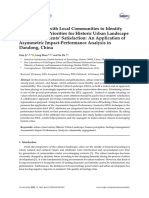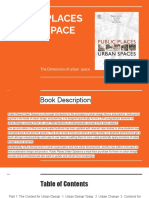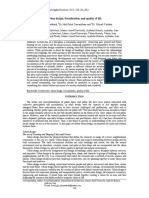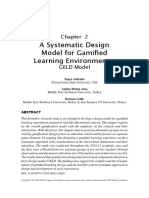Socio-Ecological Systemsof Urban Landscape: As A Governing Factor of Sustainability and An Aspect of Conservation
Socio-Ecological Systemsof Urban Landscape: As A Governing Factor of Sustainability and An Aspect of Conservation
Uploaded by
KejalCopyright:
Available Formats
Socio-Ecological Systemsof Urban Landscape: As A Governing Factor of Sustainability and An Aspect of Conservation
Socio-Ecological Systemsof Urban Landscape: As A Governing Factor of Sustainability and An Aspect of Conservation
Uploaded by
KejalOriginal Title
Copyright
Available Formats
Share this document
Did you find this document useful?
Is this content inappropriate?
Copyright:
Available Formats
Socio-Ecological Systemsof Urban Landscape: As A Governing Factor of Sustainability and An Aspect of Conservation
Socio-Ecological Systemsof Urban Landscape: As A Governing Factor of Sustainability and An Aspect of Conservation
Uploaded by
KejalCopyright:
Available Formats
Socio-ecological systemsof urban landscape: As a governing factor of
sustainability and an aspect of conservation.
Abstract: Sustainability and conservation both the necessity for future development to stop and none of
them have been studied by considering cultural and social values as an important aspect of achieving
them. This research paper focuses on Urban Landscapes as a social-ecological system as factors of
sustainable cities, sustainable design as they make the cities or place in which human live and interact
meaningful,cultural and social values in conservation and the importance of ecological factors in
governing both of them.
Introduction:Cultural landscape research may enrich ecosystem services research as it builds on a long
tradition of interdisciplinary and trans-disciplinary environmental studies. It provides different
perspectives on the interactions between man and nature, and deepens the understanding of the role of
humans in landscapes and ecosystems. Nonmaterial landscape values can be determined qualitatively,
quantitatively, or in a spatially explicit way, and can thus be integrated into accounting schemes for
ecosystem services.From a self-sufficiency point of view there is no such thing as a sustainable city.
Cities have always been dependent on their hinterlands for food and other ecosystem goods and services.
The regional or even global impact cities thus have stresses the important pedagogical role of
functioning ecosystems in cities, especially as urbanization is increasingly disconnecting people from the
nature that supports them.
1. Urban landscapes associo-ecological systems:
Urban landscapes are socio-ecological systems where natural and social processes together shape
ecosystems.
Forces of socio-ecological systems
Natural Cultural
Guided by human ideas and preferences and it is important to control these
as they are likely to cause deviating system behavior such as arrested
successions or changed seasonality.
The ecosystem services approach has become prominent in conservation science and practice.
There is an abundance of data, indicators, and models for assessing provisioning and regulating
ecosystem services. However, the concept of ecosystem services has not been successful in
capturing cultural ecosystem services in any detail. Research in the two fields “cultural landscape”
and “ecosystem services” should be conducted jointly to enhance the understanding of cultural
ecosystem services in social and ecological systems and to develop methods of assessment.
2. Culture as an important factor:
Culture changes landscapes and culture is embodied by landscapes. Both aspects of this dynamic
are encompassed by landscape ecology, but neither has been examined sufficiently to produce
cultural theory within the field. Four broad cultural principles for landscape ecology, under which
more precise principles might be organized are:
1. Human landscape perception, cognition, and values directly affect the landscape and are affected
by the landscape.
2. Cultural conventions powerfully influence landscape pattern in both inhabited and apparently
natural landscapes.
3. Cultural concepts of nature are different from scientific concepts of ecological function.
4. The appearance of landscapes communicates cultural values.
Both the study of landscapes at a human scale and experimentation with possible landscapes,
landscape patterns invented to accommodate ecological function, are recommended as means of
achieving more precise cultural principles.
Culture can change when people begin to recognize different landscape patterns as material
evidence of long held values.
Culture not only helps to explain landscape structure, it helps to suggest the enormous array of
possible human actions and constructions in the landscape, including landscapes that do not exist
now but might be designed to promote ecological function.
3. Role of socio-ecological systems in achieveing sustainability:
To gain much needed support for ecosystem preservation as well as more sustainableconsumer
demands, the places where people live and work should be designed so as tooffer opportunities
for meaningful interactions with natural world also including theservices that are essential for
human well-being; forming important aspects of liveablecities.
Landscapes reflect human activities and are imbued with cultural values; they also combine
elements of time and space, represent political as well as social and cultural constructs. Culture
is a shaping force of landscape and its character reflects the values of the people who continue
to live in it.
When necessary, optional and social activities take place together and compete with each other
and collective spaces of cities become meaningful and attractive and which affects the well-being
of users intensely. Responding human needs is the main duty of an urban landscape/environment.
Establishing the sustainability paradigm as a cultural discourse points to a more holistic foundation
for architecture that encompasses and expands on vital benchmarks already established in current
sustainable practice models. Herein lies architecture’s potential, transforming from a contributor to
the bedevilling problems of human impact on the global ecosphere, to being part of a sustaining
solution to its, and our, on-going viability.
4. Role of socio-ecological systems in conservation:
The goal of conserving a landscape should be ensuring that all interventions and
actions meet the test of authenticity in all respects and the retention of authenticity is the aim
of good conservation practice.The diversity of the intangible knowledge forms of cultural landscapes
must be mapped, evaluated and protected in order to support other preservation initiatives.
The combination of ecological and social information should be able to capture important processes
in the landscape and determine their origin and implications for sustainability, e.g., how citizens’
access to different ecosystem services affects their choices and actions.It is not the form of the city
that is sustainable or not but the processes that create it are in turn shaped by the form.
5. Sustainable Urban Development:
The expanding notion of cultural heritage to incorporate associative values and multiple
perspectives. The concept of landscape gained importance in the urban planning and development
discourses. It started to be part of many disciplines that call for the application of a landscape
approach that integrates distinct theoretical perspectives, which are usually discussed separately,
to address the complex layering of the various aspects of the landscape, including landscape
archaeology landscape urbanism and landscape ecology. These trends towards a landscape approach
to urban management are of great interest to urban conservation as they would allow the integration
of cultural heritage in the wider goals of sustainable urban development.
The practice of sustainable architecture has largely been understood as an issue of technology and
energy performance. Consequently the discourse surrounding it has remained separate from the
broader discussion of architecture as a cultural project.
However, for sustainability to fully take hold and bear fruit, it must be understood within the broad
cultural scope it clearly embodies. This is done in the context of regional responses to sustainable,
examining the relationship between sustainable building practices and regional architectural and
material cultural traditions. The examination of contemporary green building design, using the
analytic framework of three reference terms culture, process and assembly; to explore parallels
between the current practice of sustainable architecture and other contemporary cultural discourse.
Sustainable development seeks to meet the needs and aspirations of the present without
compromising the ability to meet those of future and also being sensitive with nature and the culture
related to context.
6. Relation of the identity concept:
Identity is the extent to which a person can recognize or recall a place as being distinct from
otherplaces and can vary in different situations in different people and societies hence a city’s
publicidentity is intertwined with our imagination of urban landscape. City is recognized as a product
of the complex relations between humans and nature, disrupted ecosystems and can be studied as its
structures, functions and processes; main elements being patches, corridors and the matrix.
Conclusion:
References:
RESEARCH IN ARCHITECTURE
KEJAL VIREN THAKKER
FOURTH YR. B.ARCH
DIV: B
You might also like
- Interview GuideDocument135 pagesInterview GuideShawn Teo95% (19)
- Building From Tradition PDFDocument242 pagesBuilding From Tradition PDFKejalNo ratings yet
- The Viability of Integrating Green and Vernacular Architecture in The Tourism Development of Donsol, SorsogonDocument33 pagesThe Viability of Integrating Green and Vernacular Architecture in The Tourism Development of Donsol, SorsogonVinson Pacheco Serrano0% (1)
- Krakov Charter 2000Document5 pagesKrakov Charter 2000danvcoNo ratings yet
- Research 4th YrDocument11 pagesResearch 4th YrKejalNo ratings yet
- University of Management and Technology, Lahore School of Architecture and Planning Report WritingDocument5 pagesUniversity of Management and Technology, Lahore School of Architecture and Planning Report WritingHIRA SHABBIRNo ratings yet
- Urban EcologyDocument20 pagesUrban Ecologydharan.v2006No ratings yet
- Planning 2 Arch. Marjorie MendozaDocument2 pagesPlanning 2 Arch. Marjorie MendozaHazel May Agagas EstrellaNo ratings yet
- Residents' Attitudes Toward Supporting The Heritage Sites Using The Structural Equation Modeling (Sem), Case Study: Mansoura Culture Palace, EgyptDocument22 pagesResidents' Attitudes Toward Supporting The Heritage Sites Using The Structural Equation Modeling (Sem), Case Study: Mansoura Culture Palace, EgyptDr. Ghada RaghebNo ratings yet
- Kathmandu Valley Urban Capital RegionDocument14 pagesKathmandu Valley Urban Capital RegionSafala BistaNo ratings yet
- Sustainability: Xian Ji, Long Shao and Yu DuDocument16 pagesSustainability: Xian Ji, Long Shao and Yu DuzhangweiningNo ratings yet
- Sustainable Urban Development: Bioregionalistic Vision For Small TownsDocument19 pagesSustainable Urban Development: Bioregionalistic Vision For Small TownsIEREKPRESSNo ratings yet
- Wu, J. (2014) - Urban Ecology and Sustainability The State-Of-The-Science and Future Directions. Landscape and Urban Planning, 125, 209-221 PDFDocument13 pagesWu, J. (2014) - Urban Ecology and Sustainability The State-Of-The-Science and Future Directions. Landscape and Urban Planning, 125, 209-221 PDFSIOMARA MARIBEL JURADO GARCIANo ratings yet
- PDF - Emerging Biophilic UrbanismDocument16 pagesPDF - Emerging Biophilic UrbanismHaydelyn Ann EsparesNo ratings yet
- Information Notes On Applying "Nature's Contributions To People"Document4 pagesInformation Notes On Applying "Nature's Contributions To People"Ezio AuditoreNo ratings yet
- Httpsdigitalcommons Bau Edu Lbcgiviewcontent Cgiarticle 1069&context HwbjournalDocument12 pagesHttpsdigitalcommons Bau Edu Lbcgiviewcontent Cgiarticle 1069&context HwbjournalnoorNo ratings yet
- Css MicroprojectDocument32 pagesCss Microprojectshreyassasane31No ratings yet
- Urbansci 04 00059 v2Document15 pagesUrbansci 04 00059 v2mohamedr55104No ratings yet
- Research Paper FinalDocument9 pagesResearch Paper FinalKejalNo ratings yet
- Elective 1Document42 pagesElective 1Solaisurya SolaiNo ratings yet
- Running Head: Reading Urban Landscape 1Document10 pagesRunning Head: Reading Urban Landscape 1CurieNo ratings yet
- Urban Climate Catalyst, Lima PeruDocument59 pagesUrban Climate Catalyst, Lima PeruVeronica AndersonNo ratings yet
- Principles of Intelligent UrbanismDocument16 pagesPrinciples of Intelligent UrbanismKola LawalNo ratings yet
- J Landurbplan 2014 01 018Document13 pagesJ Landurbplan 2014 01 018Alane OliveiraNo ratings yet
- IND2313 Study NotesDocument2 pagesIND2313 Study NotesJohannes WeinerNo ratings yet
- Sustainable Cities and Society: SciencedirectDocument7 pagesSustainable Cities and Society: SciencedirectCamilo ArizaNo ratings yet
- Status ReportDocument28 pagesStatus ReportNIDHI SINGHNo ratings yet
- 164-Article Text-266-1-10-20191003Document9 pages164-Article Text-266-1-10-20191003Sri SandhiyaNo ratings yet
- Module 1 Group 1 - Planning 3Document84 pagesModule 1 Group 1 - Planning 3Chanty LenchicoNo ratings yet
- Urban Ecology Course Outline & IntroductionDocument5 pagesUrban Ecology Course Outline & IntroductionMntesnotNo ratings yet
- Cultural Landscape ConservationDocument12 pagesCultural Landscape ConservationZoran PavlovNo ratings yet
- Synopsis Redefining Nature A Dynamic Exploration of ArchitecDocument4 pagesSynopsis Redefining Nature A Dynamic Exploration of ArchitecAreeba SiddiquiNo ratings yet
- Public Perceptions of Historical Authenticity Tanjin - RB Comments - 14 10 18Document20 pagesPublic Perceptions of Historical Authenticity Tanjin - RB Comments - 14 10 18aditiNo ratings yet
- Principles of Intelligent UrbanismDocument13 pagesPrinciples of Intelligent UrbanismMercury TogotoNo ratings yet
- Eliciting Cultural Heritage ValuesDocument29 pagesEliciting Cultural Heritage ValuesAliNo ratings yet
- STUDIO_URBAN_CONSERVATION_ALLEPPY_IInd_ SEM_PROGRAMMERBRIEF__25Document8 pagesSTUDIO_URBAN_CONSERVATION_ALLEPPY_IInd_ SEM_PROGRAMMERBRIEF__25Vishnupriya ManikandanNo ratings yet
- Eliciting Cultural Heritage Values: Landscape Preferences Vs Representative Images of The CityDocument30 pagesEliciting Cultural Heritage Values: Landscape Preferences Vs Representative Images of The CityFarah ChedidNo ratings yet
- studio V handout 2021Document4 pagesstudio V handout 2021Elif FatimaNo ratings yet
- Urban Green Space System Planning: Bayram Cemil Bilgili and Ercan GökyerDocument12 pagesUrban Green Space System Planning: Bayram Cemil Bilgili and Ercan GökyerRauzaNo ratings yet
- Chapter 1 - Abstract & IntroductionDocument4 pagesChapter 1 - Abstract & IntroductionDivyadharshini KNo ratings yet
- 693Document16 pages693IdaHodzicNo ratings yet
- Apl412 - RSW - FN02 - Cardenas - Julie Ann - 4BDocument27 pagesApl412 - RSW - FN02 - Cardenas - Julie Ann - 4BJulie Ann QuimingNo ratings yet
- 01 HENVI Workshop 2012Document16 pages01 HENVI Workshop 2012subhas9804009247No ratings yet
- 2010 Reed The Agency of EcologyDocument1 page2010 Reed The Agency of EcologyjosefbolzNo ratings yet
- Conference Paper Berk 1Document12 pagesConference Paper Berk 1Tricia LimNo ratings yet
- Cultural SustainabilityDocument8 pagesCultural SustainabilityMark Russell DimayugaNo ratings yet
- SumberawanDocument8 pagesSumberawanEmma Y. TitisNo ratings yet
- Contextualism and SustainabilityDocument20 pagesContextualism and SustainabilityYoungjk KimNo ratings yet
- Advancing Urban Ecology Toward A Science of Cities: Overview ArticlesDocument15 pagesAdvancing Urban Ecology Toward A Science of Cities: Overview ArticlesTarek Mohamed Tarek FouadNo ratings yet
- Urban Design, Socialization, and Quality of LifeDocument5 pagesUrban Design, Socialization, and Quality of LifeericNo ratings yet
- Decoding The Semantics of Cultural EcoloDocument8 pagesDecoding The Semantics of Cultural EcoloBetter life betterNo ratings yet
- Konsep Perencanaan Permukiman Tepi Sungai Yang Berwawasan EkologiDocument6 pagesKonsep Perencanaan Permukiman Tepi Sungai Yang Berwawasan EkologiMyrabukitbatasNo ratings yet
- University of Engineering and Technology Peshawar, Abbottabad CampusDocument8 pagesUniversity of Engineering and Technology Peshawar, Abbottabad CampusWONDERS OF WORLDNo ratings yet
- Cilliers 2014Document11 pagesCilliers 2014ainin bashirohNo ratings yet
- Annotated BibliographyDocument8 pagesAnnotated BibliographyANGELICA MAE HOFILEÑANo ratings yet
- Architecture and Nature at The End of The For Sustainable Design in Architecture 20th Century: Towards A Dialogical ApproachDocument11 pagesArchitecture and Nature at The End of The For Sustainable Design in Architecture 20th Century: Towards A Dialogical ApproachMaraiah De SagunNo ratings yet
- City As An OrganismDocument14 pagesCity As An OrganismVeronika AntoniouNo ratings yet
- Shaping Communities Through Urban Green: Author DetailsDocument10 pagesShaping Communities Through Urban Green: Author DetailsHarshiniNo ratings yet
- Library PermacultureDocument24 pagesLibrary PermacultureEdgardo CivalleroNo ratings yet
- RoleofAchitectinRuralcommunity NoahDocument13 pagesRoleofAchitectinRuralcommunity NoahC KNo ratings yet
- WSI-MT-007 (053) - Loso Judijanto1, Dkk-TemplateDocument10 pagesWSI-MT-007 (053) - Loso Judijanto1, Dkk-TemplateAsyraafNo ratings yet
- Reinventing Traditional Technologies For PDFDocument11 pagesReinventing Traditional Technologies For PDFKejalNo ratings yet
- Introducing Emotions in The Architectural Design Process: June 2015Document7 pagesIntroducing Emotions in The Architectural Design Process: June 2015KejalNo ratings yet
- Prof. Jyoti Jain Tholiya PH: +91 9860798500: GIS Assignment 1: QuizDocument6 pagesProf. Jyoti Jain Tholiya PH: +91 9860798500: GIS Assignment 1: QuizKejal0% (1)
- GIS Applications To Smart Cities: February 2018Document4 pagesGIS Applications To Smart Cities: February 2018KejalNo ratings yet
- Research Paper FinalDocument9 pagesResearch Paper FinalKejalNo ratings yet
- Research in Architecture - I Final Research Seminar: 7 Oct 2019 Academic Year: 2019 - 2020 NDMVP'S College of Architecture, NashikDocument8 pagesResearch in Architecture - I Final Research Seminar: 7 Oct 2019 Academic Year: 2019 - 2020 NDMVP'S College of Architecture, NashikKejalNo ratings yet
- Keywords:: Climate Responsive Design, Thermal Comfort, Vernacular Architecture, SolarDocument10 pagesKeywords:: Climate Responsive Design, Thermal Comfort, Vernacular Architecture, SolarKejalNo ratings yet
- JECCDocument2 pagesJECCKejal100% (1)
- Climate Responsive Architecture: Vernacular Architecture As The Source For Energy Efficiency and Thermal ComfortDocument8 pagesClimate Responsive Architecture: Vernacular Architecture As The Source For Energy Efficiency and Thermal ComfortKejalNo ratings yet
- JECCDocument2 pagesJECCKejal100% (1)
- Earnest Burgess Concentric Zone ModelDocument22 pagesEarnest Burgess Concentric Zone ModelKejal50% (2)
- Tony GarnierDocument13 pagesTony GarnierKejal100% (1)
- Research MethodologyDocument6 pagesResearch MethodologyDusha Periyasamy100% (1)
- Antropology Open SourceDocument8 pagesAntropology Open SourceaquemdoequadorNo ratings yet
- Formulating Research TitlesDocument3 pagesFormulating Research Titlesmuna moono100% (1)
- History and Philosophy of History HPH ADocument22 pagesHistory and Philosophy of History HPH Apopmarko43No ratings yet
- MC Research Module 3Document8 pagesMC Research Module 3payno gelacioNo ratings yet
- Research Methodology ChecklistDocument1 pageResearch Methodology ChecklistkiminochiNo ratings yet
- Thesis Topics For M.phil in EducationDocument8 pagesThesis Topics For M.phil in Educationogjbvqvcf100% (2)
- Mental Health and Its Impact On Generation Z IndividualsDocument6 pagesMental Health and Its Impact On Generation Z IndividualsshackNo ratings yet
- Project Slide: Cracks in BuildingDocument2 pagesProject Slide: Cracks in BuildingBrian WarnerNo ratings yet
- First Periodic Exam SHS Test B - Practical Research 1 2017Document2 pagesFirst Periodic Exam SHS Test B - Practical Research 1 2017Ariel Nube83% (18)
- The Impact of Active Participation of YFC (Youth For Christ) Among The Youth of Oslob To Their Spiritual Life.Document57 pagesThe Impact of Active Participation of YFC (Youth For Christ) Among The Youth of Oslob To Their Spiritual Life.Dayne LegardeNo ratings yet
- Causal ResearchDocument5 pagesCausal ResearchnirajmishraNo ratings yet
- AIEMS CollegeDocument11 pagesAIEMS CollegeVigneshkumarNo ratings yet
- Feature and Column WritingDocument130 pagesFeature and Column WritingRajamohanNo ratings yet
- PR2 HeDocument12 pagesPR2 HeJay-r MatibagNo ratings yet
- The Problem: Rational and Background: Fiat Lux AcademeDocument74 pagesThe Problem: Rational and Background: Fiat Lux AcademeJaira JaranaNo ratings yet
- How To Contact Thesis SupervisorDocument5 pagesHow To Contact Thesis Supervisortishanoelfrisco100% (2)
- Net JRF Updated Yyllabus - Share With FriendsDocument176 pagesNet JRF Updated Yyllabus - Share With FriendsGanesh raj100% (5)
- Sociology Term Paper OutlineDocument7 pagesSociology Term Paper Outlinec5qxb4be100% (1)
- Academic Procrastination and Stress Among Senior High School StudentsDocument5 pagesAcademic Procrastination and Stress Among Senior High School Studentsjohn rix PalacioNo ratings yet
- Language Cognitive Strategy Analysis in Learner Diaries of College Freshman Students in Kalinga State University, PhilippinesDocument10 pagesLanguage Cognitive Strategy Analysis in Learner Diaries of College Freshman Students in Kalinga State University, PhilippinesIJELS Research JournalNo ratings yet
- Representation Skills of Students With Different Ability Levels When Learning Using The LCMR ModelDocument16 pagesRepresentation Skills of Students With Different Ability Levels When Learning Using The LCMR ModelSri HaryatiNo ratings yet
- A Systematic Design Model For Gamified Learning EnvironmentsDocument27 pagesA Systematic Design Model For Gamified Learning EnvironmentsHeba NoiemNo ratings yet
- Coursework University of ManchesterDocument7 pagesCoursework University of Manchesterbcrs13f4100% (2)
- 1 PBDocument16 pages1 PBfreepdf pleaseNo ratings yet
- Assignment Help ServicesDocument7 pagesAssignment Help ServicesohuudshjfNo ratings yet
- International Business RESIT Summative Assessment BriefDocument12 pagesInternational Business RESIT Summative Assessment BriefSahibzada Abu Bakar GhayyurNo ratings yet
- Conceptual FrameworkDocument7 pagesConceptual FrameworkPiyam RazaNo ratings yet
- DST-JSPS Call For Proposals 2020Document3 pagesDST-JSPS Call For Proposals 2020Dr-Bharath Vedashantha MurthyNo ratings yet




































































































